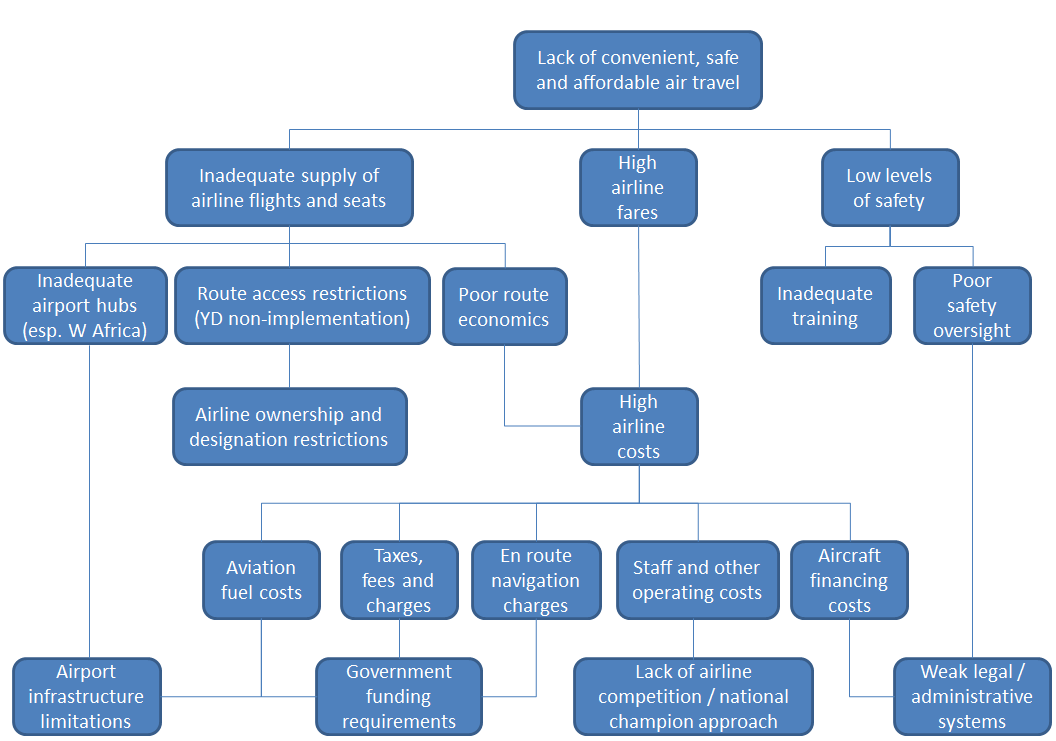Air transport liberalisation in Africa
Africa’s population is growing rapidly. The current high population growth rate began in the second half of the 20th century.
Africa’s population is growing rapidly. The current high population growth rate began in the second half of the 20th century, when the number of people on the continent almost quadrupled from 230 million to 811 million. By 2010 this number reached one billion and if current demographic trends persist, Africa’s population will be 1.4 billion in 2025 and 1.9 billion by 2050.
The size and rate of expansion of a country’s population, its wealth and trade activity are all indicators of the level of aviation activity that might be expected. Cities with a large population and GDP and high airline capacity (seats) may indicate a potential location for a viable hub. Nevertheless, there are only a few significant hubs in Africa such as Johannesburg (with the largest level of connecting traffic) followed by Addis, Cairo, Casablanca and Nairobi. The low level of connectivity in West Africa is notable, reflecting the lack of hub airlines.
Steer Davies Gleave, in a study for the Infrastructure Consortium for Africa (ICA) aiming to assist African stakeholders in addressing the next steps in promoting efficient African aviation services, found that there are several root causes of barriers to African aviation, as shown below:
Airline Fares and Costs
On analysing the route costs on some typical intra African routes and comparing them against published fares for the same routes and for routes of similar length in Europe and India, we found that (on average) costs and fares are 1.5 – 2 times higher than those in Europe and 2.5 – 3 times higher than those in India. Given levels of economic development it would be expected that fares in Africa should be more similar to those in India and certainly should not be higher than those in Europe.
Load Factors and Cost Breakdown
One of the major contributors to high fares and costs is load factors. Average load factors in Africa are around 60 (Ethiopian Airways) whereas EasyJet in Europe achieves 89% and SpiceJet in India 74%. It was shown that if African carriers achieved an 80% load factor, their unit costs would be lower and much closer to European unit costs.
Other factors contributing to high African unit costs include: high fuel costs due to poor infrastructure, high airport taxes, high staff costs/“other” costs (maintenance, commercial costs), on average 20%, 25% and 50% higher than Europe/India, respectively.
The vicious circle between high costs and low demand
There is a vicious circle linking high costs and low demand, with high fares leading to low load factors and reduced efficiency, hence keeping costs high. In order to break down these barriers to aviation a reduction in external costs, such as fuel and airport charges, is required through infrastructure improvements and potential regional discounts on charges. Further, by improving airline efficiency and potentially reducing fares to increase load factors, the vicious circle of high costs and low load factors could be broken, resulting in an affordable, cost efficient aviation offer.
Liberalisation
Two key treaties/decisions in Africa relating to liberalisation in the aviation market are the Yamoussoukro Decision (YD) and the ECOWAS Treaty. The objective of the former is the gradual liberalisation of scheduled and non-scheduled intra-African air transport services. Of the 54 African states, 44 have signed and formally became parties to the YD and in theory, therefore, should have a liberalised air transport market in operation, both within and between them. In practice, however, this is not the case: the YD has not been implemented, or has only been partly implemented, and whilst it is cited on occasion in bilateral air service agreements, it is not, in practice, taken into account during negotiations for air traffic rights.
Experience in other countries shows liberalisation provides opportunities for airlines and benefits for consumers, resulting in passenger growth. In an African context, incremental steps and confidence building measures are more likely to succeed than a big bang approach. We suggest building on efforts at the Regional Economic Community (REC) level, with measures such as multiple airline designation, airline ownership/control rules and provisions for arbitration using existing, or new, REC-based institutions.






















